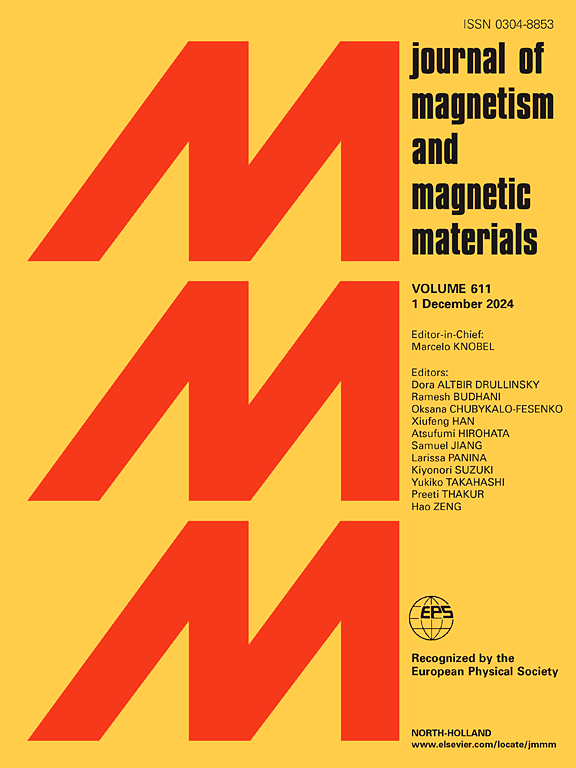用密度泛函理论计算ni吸附Nb2C-OF MXene的磁性行为
IF 2.5
3区 材料科学
Q3 MATERIALS SCIENCE, MULTIDISCIPLINARY
引用次数: 0
摘要
磁性二维材料由于其令人鼓舞的应用而获得了极大的关注。由于缺陷的发生、过渡金属的掺杂或吸附或表面功能化,这些二维材料的变化可以引发这些材料的自旋极化和磁性能。利用密度泛函理论(DFT)确定了合成的二维材料的电、磁性能、电子结构和稳定性。本文描述了Ni-ad-Nb2C-OF MXene的磁性能。研究的重点是基于第一主计算的计算方法,提供了对吸附化合物的磁性能的深入了解,并将其与原始的Nb2C-OF MXene进行了比较。采用Wien2k软件对原始Nb2C-OF和Ni-ad-Nb2C-OF结构进行了模拟和优化。使用交换相关函数;自旋- gga和自旋- gga + U(对于U = 6 eV的镍),发现Ni-ad-Nb2C-OF的电子带结构为金属结构,磁矩计算为+ 1.01516 μβ,具有非超导和铁磁性。由于这种磁性,这种二维化合物在自旋电子学和纳米级磁性数据存储技术中具有新兴应用的潜力。本文章由计算机程序翻译,如有差异,请以英文原文为准。
Computational study of magnetic behaviour in Ni-adsorbed Nb2C-OF MXene using density functional theory
Magnetic 2D materials have achieved significantly consideration owing to their encouraging applications. A variation of these 2D materials by occurrence of defects, by the transition-metal doping or adsorption or by the surface functionalization can initiate both the spin-polarization and magnetic properties in these materials. Density functional theory (DFT) is used to determine the electric, magnetic properties along with the electronic structures and stability of synthesized two-dimensional materials. This work describes the magnetic properties of Ni-ad-Nb2C-OF MXene. The study focuses on the computational approach based first principal calculation providing insight onto the magnetic properties of adsorbed compound and comparing it with pristine Nb2C-OF MXene. The pristine Nb2C-OF and Ni-ad-Nb2C-OF structures are simulated and optimized using Wien2k software. Using exchange-correlational functionals; spin-GGA and spin-GGA + U (for Nickel U = 6 eV), Ni-ad-Nb2C-OF electronic band structure is found to be metallic having magnetic moment calculated + 1.01516 showing its non-superconducting and ferromagnetic properties. Owing to this magnetic properties, this 2D compound holds potential for emerging applications in spintronics and nanoscale magnetic data storage technologies.
求助全文
通过发布文献求助,成功后即可免费获取论文全文。
去求助
来源期刊

Journal of Magnetism and Magnetic Materials
物理-材料科学:综合
CiteScore
5.30
自引率
11.10%
发文量
1149
审稿时长
59 days
期刊介绍:
The Journal of Magnetism and Magnetic Materials provides an important forum for the disclosure and discussion of original contributions covering the whole spectrum of topics, from basic magnetism to the technology and applications of magnetic materials. The journal encourages greater interaction between the basic and applied sub-disciplines of magnetism with comprehensive review articles, in addition to full-length contributions. In addition, other categories of contributions are welcome, including Critical Focused issues, Current Perspectives and Outreach to the General Public.
Main Categories:
Full-length articles:
Technically original research documents that report results of value to the communities that comprise the journal audience. The link between chemical, structural and microstructural properties on the one hand and magnetic properties on the other hand are encouraged.
In addition to general topics covering all areas of magnetism and magnetic materials, the full-length articles also include three sub-sections, focusing on Nanomagnetism, Spintronics and Applications.
The sub-section on Nanomagnetism contains articles on magnetic nanoparticles, nanowires, thin films, 2D materials and other nanoscale magnetic materials and their applications.
The sub-section on Spintronics contains articles on magnetoresistance, magnetoimpedance, magneto-optical phenomena, Micro-Electro-Mechanical Systems (MEMS), and other topics related to spin current control and magneto-transport phenomena. The sub-section on Applications display papers that focus on applications of magnetic materials. The applications need to show a connection to magnetism.
Review articles:
Review articles organize, clarify, and summarize existing major works in the areas covered by the Journal and provide comprehensive citations to the full spectrum of relevant literature.
 求助内容:
求助内容: 应助结果提醒方式:
应助结果提醒方式:


